Mark Curtis looks at the current war in Gaza from the perspective of Britain’s imperial past in this edited extract from his book Secret Affairs: Britain’s Collusion with Radical Islam.

July 1, 1946: U.K. soldiers during curfew in Tel Aviv during the Zionist underground’s campaign against British mandatory rule in Palestine. (Hans Pinn, National Library of Israel, Wikimedia Commons, Public domain)
By Mark Curtis
Declassified UK
 After the Second World War British planners were confronted by the outbreak of a Jewish uprising in Palestine, which the U.K. had run since securing a “mandate” from the then League of Nations in 1922.
After the Second World War British planners were confronted by the outbreak of a Jewish uprising in Palestine, which the U.K. had run since securing a “mandate” from the then League of Nations in 1922.
This uprising led to a series of momentous events that shape the present-day Middle East: the British decision in February 1947 to withdraw from Palestine, the U.N.’s decree in November 1947 to partition the territory, the Jewish declaration of the state of Israel in May 1948 and the first Arab–Israeli war, in which Israeli forces annexed much of Palestine by December of that year.
Near the end of the Second World War, the leadership of the Yishuv, the Jewish settler community in Palestine, headed by David Ben-Gurion, had embarked on a campaign to push the British out of the territory.
A wave of terrorist attacks was conducted against British forces and Palestinian Arabs, in response to which the British declared martial law, enacted draconian emergency regulations and undertook brutal collective punishments on local Jewish communities.
Jewish antagonism towards Britain was shaped partly by London’s policy on Jewish immigration from Germany and elsewhere which, in deference to Arab objections, Britain was now trying to restrict.
During the last three years of the mandate, 40,000 illegal immigrants succeeded in entering Palestine, but shiploads of Jewish refugees regarded as illegal were intercepted at sea.
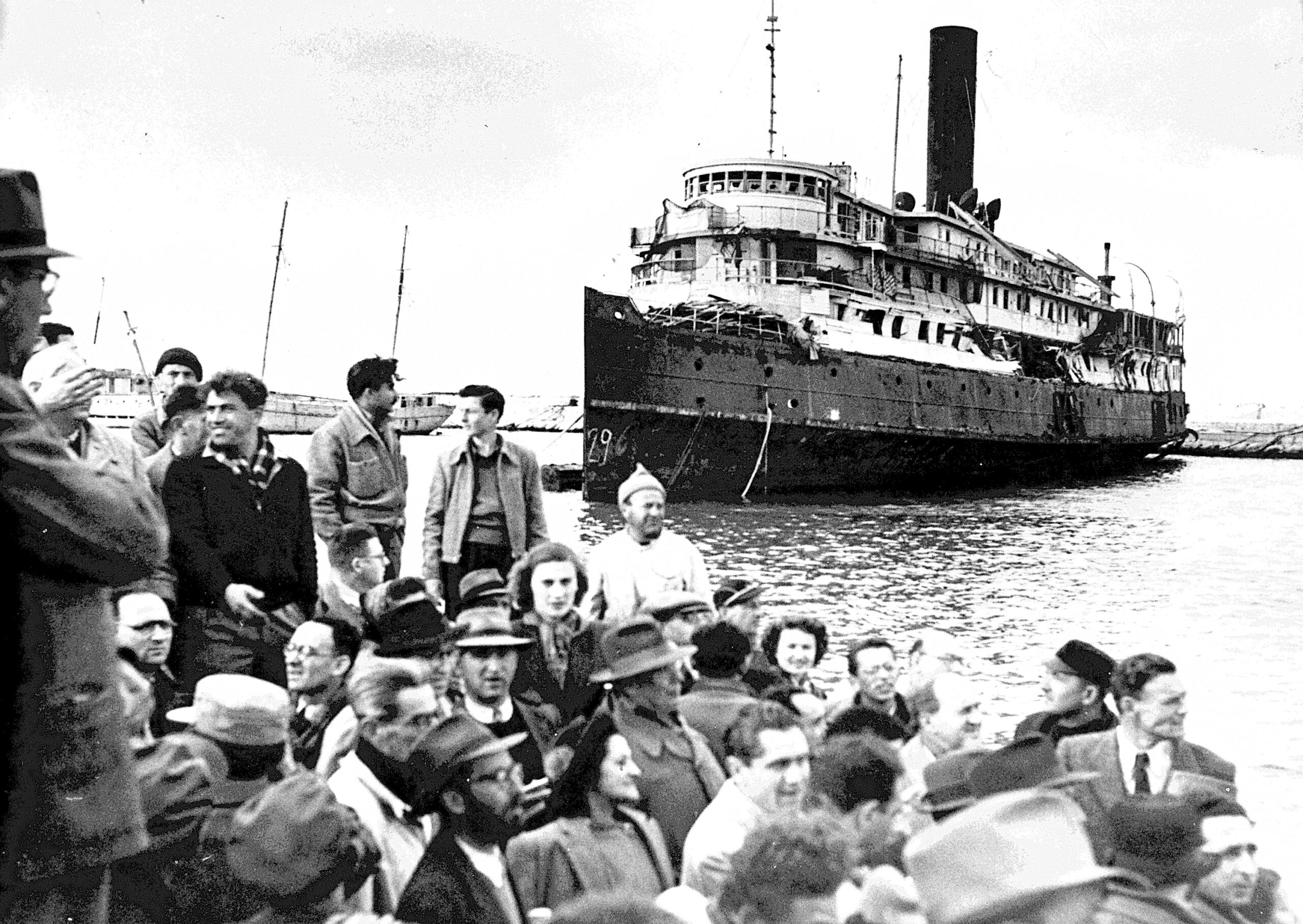
Scene of immigration to Israel, July 1947, no location provided. (The Palmach Archive, Wikimedia Commons, Public domain)
In 1946 the Royal Navy turned back 17 ships carrying refugees to their ports of origin, while MI6 [British foreign intelligence service] was instructed to sabotage some of the transport ships while in port.
The policy continued throughout 1947, and by December of that year over 51,000 passengers on 35 ships had been intercepted and interned by the British in Cyprus.
By this time, Clement Attlee’s Labour government had decided to give up on finding its own solution to the rebellion and had resolved to relinquish the mandate and hand the problem over to the recently formed United Nations.
‘Economic & Military Liability’
At a time when Britain was faced with numerous demands on its resources, the Jewish uprising was clearly not going to be overcome quickly or cheaply, and Attlee regarded Palestine as “an economic and military liability.” [Ed.: On July 22, 1946 the Jewish terrorist group Irgun bombed the King David Hotel in Jerusalem, where the British administrative headquarters for Mandatory Palestine was located, killing 91 people.]
Britain now began to promote the partition of Palestine into Jewish and Arab states, a policy supported by the Jewish leadership but which immediately undermined the interests of the Palestinians, who at the time made up around two-thirds of the population, compared to one-third of Jews.
In November 1947, the U.N. passed General Assembly Resolution 181, partitioning Palestine and awarding the Jews a state that comprised over half the country, against the will of the indigenous, majority population.
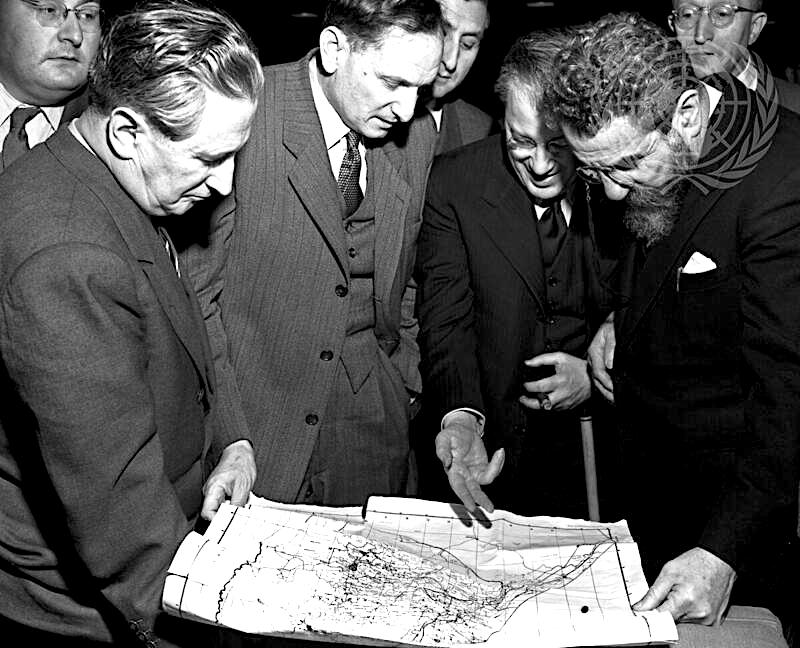
Members of the Jewish Agency delegation study a map of proposed partition of Palestine at the United Nations interim headquarters, Nov. 12, 1947. (UN Photo/MC)
In his outstanding book on the 1948 Arab–Israeli War, The Ethnic Cleansing of Palestine, Israeli historian Ilan Pappé notes that a month after the U.N. resolution, the Jewish leadership embarked on the “ethnic cleansing of Palestine.”
[Related: WATCH: Ilan Pappé — ‘Dehistoricizing Oct. 7’]
This began with a series of attacks on Arab villages following the vandalisation by some Palestinians of buses and shopping centres in protest at the resolution.
The same month the Arab League decided to form an Arab volunteer force to “liberate” Palestine. Known as the Arab Liberation Army (ALA), and consisting of around 5,000 volunteers from Syria, Iraq, Egypt and Jordan, the force began operations in Palestine against Jewish forces in January 1948.
As warfare among Jews and Palestinians increased, the Jewish leaders’ plans culminated in a meeting in March 1948 which decided on a “Plan D”, the “systematic expulsion of the Palestinians from vast areas of the country,” Pappé notes.
When the British withdrew from Palestine in May, the Jewish Agency declared independence and the regular armies of the Arab states invaded Palestine; brutal fighting ensued between an estimated 98,000 Jewish forces and 50,000 on the Arab side.
Annexing the West Bank
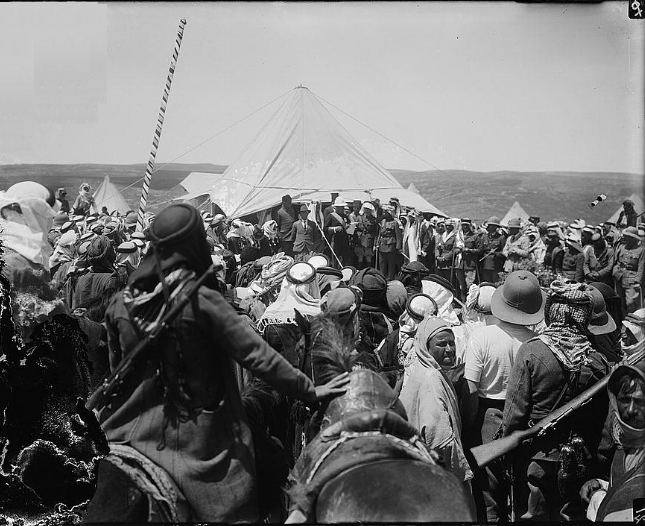
Arab, Bedouin and British officials meeting around April 17-27, 1921, at Amir Abdullah ibn Hussein’s camp at Amman, Jordan, during which British High Commissioner Herbert Samuel proclaimed Amir Abdullah ruler of Transjordan, under British protection. (American Colony, Jerusalem, Photo Dept.,Wikimedia Commons, Public domain)
Not all Arab states opposed Israel, however. Transjordan’s King Abdullah, a British-backed monarch still reigning after being installed by London a quarter of a century earlier, entered into a tacit alliance with Israel not to join in any pan-Arab military operations against the Jewish state, and to quietly recognise its existence.
In return, Abdullah would be permitted to annex most of the areas allocated to the Arabs under the partition resolution, the lands on the West Bank of the river Jordan.
This unwritten agreement, reached in January 1948, resulted in the neutralisation of the Arab world’s most effective fighting force, the British-backed Arab Legion, based in Transjordan and commanded by the British officer, Sir John Bagot Glubb.
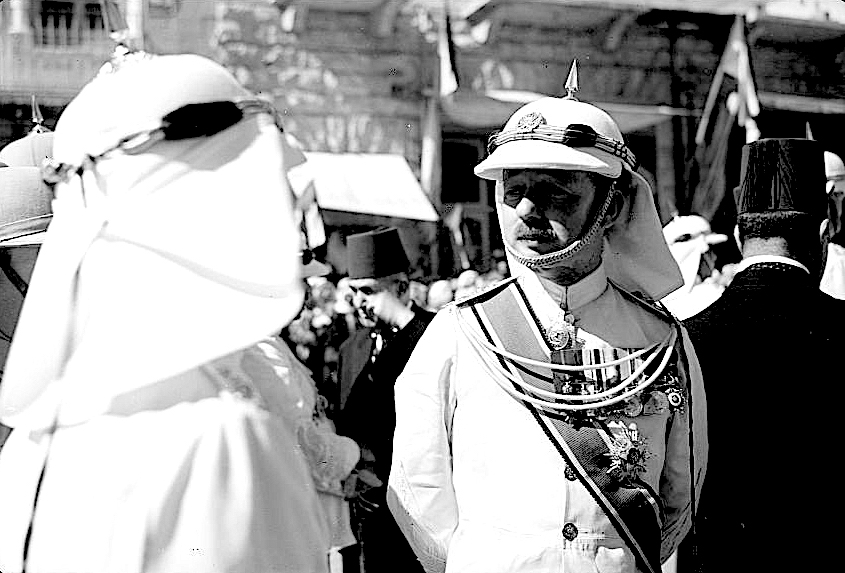
Sept. 11, 1940: Glubb in Amman during celebrations of the 24th anniversary of the Arab Revolt. (G. Eric and Edith Matson, Photograph Collection, Library of Congress Prints and Photographs Division, Wikimedia Commons, Public domain)
In May, the same month that the state of Israel was founded, the British ambassador in Transjordan, Sir Alex Kirkbride, wrote to Foreign Secretary Ernest Bevin.
He reported that:
“… there have been negotiations between the Arab Legion and the Hagana [the Jewish paramilitary force] which have been conducted by British officers of the Arab Legion. It is understood that the object of these top secret negotiations is to define the areas of Palestine to be occupied by the two forces.”
Bevin replied:
“I am reluctant to do anything that might prejudice the outcome of these negotiations.”
His response was typical of the line the British were now taking on Israel–Palestine.
In late May 1948, the British supported the Arab states in opposing a ceasefire resolution at the U.N. that was accepted by the Israelis, who had by now annexed a large amount of Palestinian territory and were content to consolidate their gains.
The reason for British policy was the hope that Abdullah’s forces would soon capture the West Bank; once it became clear in late May that they had annexed the territory, Britain lifted its opposition to the ceasefire (which later broke down).
The formal unification of the two banks of the river Jordan occurred two years later, in April 1950. Britain was one of only two states, along with Yemen, which then recognised the enlargement of Abdullah’s kingdom.
British support for “Greater Transjordan,” the Foreign Office’s chosen method for solving the Palestine problem, was intended to make Abdullah, London’s closest ally in the Arab world, the heir to Arab Palestine.
If Britain was not able to maintain its own presence in the region, it aimed to do so by proxy through its client state — a strategy typical of postwar British foreign policy.
Standing Idly By
As British planners focused on this territorial aim, they became deeply implicated in the Israelis’ ethnic cleansing of other parts of Palestine.
The British commander in the territory, General Sir Gordon Macmillan, had 50,000 troops in Palestine but was under strict directives from London not to get embroiled in military action against either Arabs or Jews, so long as they did not interfere with Britain’s plans for withdrawal.
Ilan Pappé notes that the British probably knew of Plan D, and even announced, soon after it began to be implemented, that their forces would not be responsible for law and order in the areas where they were stationed but would simply protect themselves.
This meant that huge areas of Palestine, notably the towns of Haifa and Jaffa but also numerous rural villages, could now be taken over by the Israelis without fear of a British response.
British forces stood idly by as Israeli forces destroyed Arab villages and forced out their inhabitants.
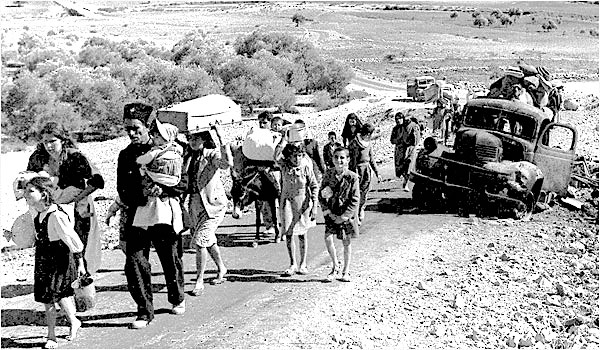
Palestine refugees making their way from Galilee in October–November 1948 during the Nakba. (Fred Csasznik, cover of The Birth of the Palestinian Refugee Problem by Benny Morris, Wikipedia commons, Public domain)
In April 1948, British forces, which had hitherto acted as a buffer between Jewish and Arab forces in Haifa, the largest port town, announced to the Jewish authorities there that they would be withdrawing.
This sent a green light to proceed with the city’s “de-Arabisation,” which involved expelling its 75,000 Palestinian residents, and is described by Pappé as “one of the most shameful chapters in the history of the British empire in the Middle East.”
The same fate befell the city of Jaffa, which was taken in May 1948 after a three-week long siege by Israeli forces, who succeeded in expelling the entire population of 50,000 with the “help” of British mediation.
In parts of Jerusalem, the British even disarmed the few Arab residents defending themselves against Jewish attacks on their neighbourhoods.
The British also aided Israel’s annexation of Palestine in other ways, such as handing over land ownership deeds for villages, which provided vital information to aid the depopulation process.
Backing the Other Side
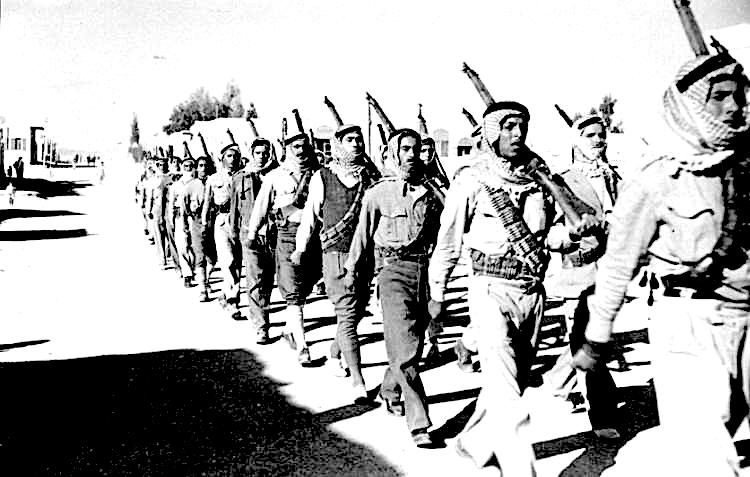
The Arab Liberation Army on parade in 1948, location not provided. (Motke Ben-Zur, Palmach Archive, Wikimdia Commons, Public domain)
Yet Britain also provided some support to the Arab side, though it is unclear if this was a policy set in London or the result of officials’ choices on the ground.
The Arab Liberation Army was commanded by Fawzi al-Qawqji, a Beirut-born army officer who had fought with the Palestinians against the British in the 1936-9 Arab Revolt that took place in the mandate.
Many of the ALA’s volunteers were Muslim Brothers from Egypt, inspired by its leader, Hassan al-Banna’s call to participate in the Palestinian jihad; many also owed allegiance to the mufti, Haj Amin al-Husseini, the exiled leader of the Palestinians living in Cairo.
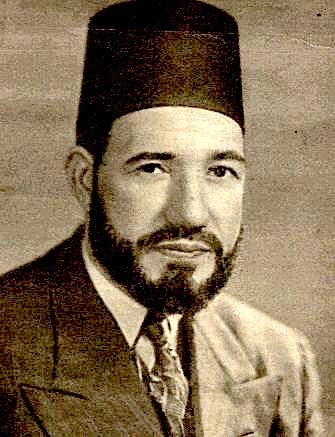
Hassan al-Banna, founder of the Muslim Brotherhood, undated. (Wikimedia Commons, Public domain)
One of the leaders in the volunteer force was the Egyptian, Said Ramadan, personal secretary to al-Banna, who would later become the chief organiser of the international Muslim Brotherhood and help establish Brotherhood branches around the world.
The first batch of up to 2,000 Egyptian Muslim Brothers reached Palestine in April 1948; crossing the Egyptian border they attacked Israeli forces in the Negev Desert.
The ALA’s activities were being extensively monitored in British intelligence reports. As the British pulled out of Palestine, they handed over many of their arms and forts to Arab forces, who often received notice of impending moves from sympathisers in the Palestine police or the British army.
Thus Iraqi volunteers were reportedly inside the Allenby Barracks in southern Jerusalem a week before British forces had given up the camp. In April 1948, the British also handed over three police stations to the ALA in the northern city of Safed, near the Syrian border — an area allocated to the Arabs under the partition plan — which greatly strengthened the Arab forces’ position in the face of a Jewish offensive.
Arab Intervention
British policy vacillated between allowing ALA incursions into Palestine and trying to prevent them, with decisions apparently left to local commanders on the ground.
When the ALA made its first attack on Jewish settlements in the Palestinian West Bank in January 1948 the British at first protested to Syria, but this was ignored and ALA incursions intensified.
In contrast, Sir Alec Kirkbride persuaded Transjordan’s King Abdullah not to allow the transfer of Arab volunteers through his kingdom, fearing they might be used to mount a coup against his regime. In early 1948 Abdullah even sent his army to block the entry into Transjordan of Saudi volunteers trying to get to Palestine.
Although individual British officials sometimes acquiesced in small-scale incursions into Palestine by Arab forces, the British Cabinet decided in February 1948 to oppose a large-scale invasion by Arab states.
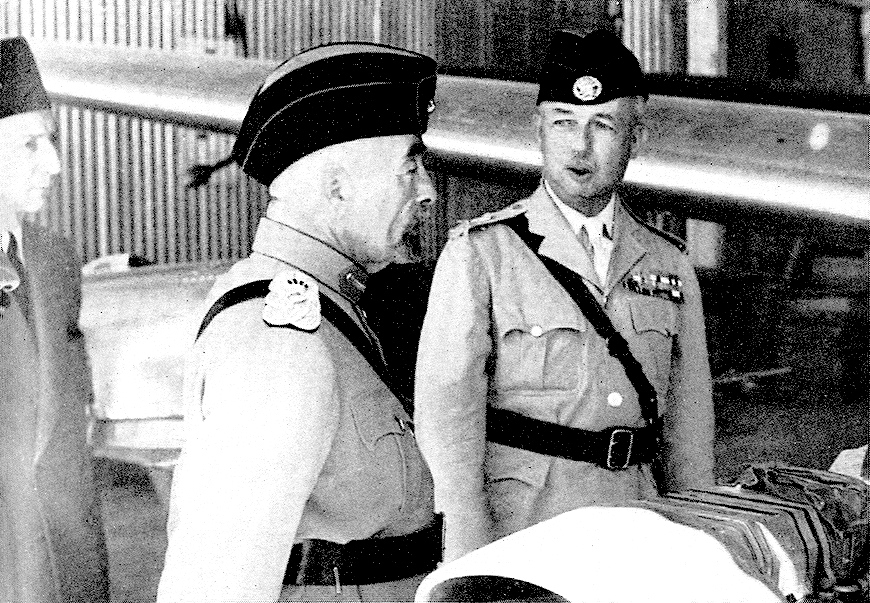
King Abdullah of Jordan with John Bagot Glubb on Jan. 1, 1951, the day before the king was assassinated. (Wikimedia Commons, Public domain)
But the regular Arab armies that did intervene in May after Britain’s withdrawal, those of Egypt, Iraq and Jordan, were all commanded by British-backed monarchs and equipped with British arms.
Britain declared an arms embargo on both sides fighting in Palestine, which had the effect of crippling the Arab forces by not allowing them to replenish their stocks. At the same time, the newly-formed Israeli army received a large shipment of heavy arms from Czechoslovakia and the Soviet Union in May.
This British policy has been interpreted by some analysts as allowing London to control the effectiveness of the Arab armies by supplying or denying them arms at key points.
The Egyptian political analyst, Mohamed Heikal, later a key adviser to President Gamel Nasser, noted that Britain provided Egypt with enough arms “to enter the war, but not enough to win.”
However, RAF photo reconnaissance squadrons based in Egypt also mounted numerous clandestine flights over Israel in 1948, photographing Israeli military movements which may have been passed on to the Arab states.
‘Non-Interference’
By December 1948, the Palestinian and Arab forces had been defeated and Israeli troops had captured the territory designated to it under the U.N. partition plan, plus around half of the territory designated for the Arabs.
Around half of Palestine’s native population, over 700,000 people, had been uprooted and over 500 villages destroyed.
Over 60 years on from the first Arab–Israeli conflict, there remains disagreement as to whose “side” Britain was really on — indeed, whether British policy-makers themselves knew what they were doing in the later chaotic stages of withdrawal from Mandate Palestine.
To some analysts, British policy was marked by a mixture of incoherence and indecision. British policy was consistent in some respects, aimed at promoting its major ally in the region, Jordan, which was bent on annexing the West Bank.
The official policy of “non-interference” had the effect of assisting the stronger side, meaning acquiescence in Israel’s take-over of most of Palestine and “ethnic cleansing,” which included the “transfer” of Palestinian Arabs into Jordan.
At the same time, however, Britain’s support for some Arab military activities was intended to avoid jeopardising relations with its Arab clients and to strengthen British influence in the region after the conflict.
Overall, Britain appears to have attempted to establish some kind of “balance” in the conflict and in the region, to serve ongoing interests.
Mark Curtis is an author and editor of Declassified U.K., an investigative journalism organisation that covers Britain’s foreign, military and intelligence policies. He tweets at @markcurtis30. Follow Declassified on twitter at @declassifiedUK
This is an edited extract from Mark Curtis’ book, Secret Affairs: Britain’s Collusion with Radical Islam.
This article is from Declassified UK.
The views expressed are solely those of the author and may or may not reflect those of Consortium News.

Thanks for the brilliant article and photos, the history has been largely forgotten . Yes, the British and American’s consider themselves to be exceptional, so did Hitler’s Nazi Germany, and so does Israel, they are the Chosen people, they say. Two world wars were inflicted on the world by European countries.
All the exceptionally bad and chosen people need psychiatric treatment. How they make the world’s people suffer! International law and human rights ignored and trashed.
Excellent article, thank you!
When has Britain not aided ethnic cleansing in Palestine?
UK/US = the Asses of Evil. Then…as now.
Britain was an empire builder. It considered itself to be the exceptional people in the same manner that the USA does today. Its government was intent on controlling the rest of the world in the interests of British wealth. That wealth was not intended for all Britons, just those who wore the right school tie.
The people Britain sent to its “colonies” were very different to the British government. They were usually honest people with good intentions who believed that British “values” could improve the world. In their own minds they did their best for the colonies.
It is the variance between the British government plans and the British official’s actions which confuses history.